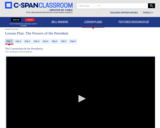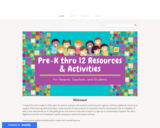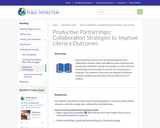
This module is designed to give 8th graders a glance at how their Personality is created.
- Subject:
- Family and Consumer Sciences
- Material Type:
- Module
- Author:
- Kayla Maller
- Date Added:
- 06/19/2018

This module is designed to give 8th graders a glance at how their Personality is created.

The executive branch was created by Article II of the U.S. Constitution and is headed by the President of the United States. The Constitution granted the president many powers, including to execute the laws of the country. However, much of the language of Article II is vague, and therefore the powers of the president have evolved over time. In this lesson, students will learn about the powers of the president and how they have grown and been used throughout our history.

The Practices Inquiry Learning Module 2 is based on foundations of inquiry described in Student Data Inquiry Module 1 . This module provides interactive training and guidance focused on furthering needs assessment by conducting inquiry into educator practices as likely root causes for student outcomes.

Module 1 sets the stage for expanding students' understanding of transformations by exploring the notion of linearity. This leads to the study of complex numbers and linear transformations in the complex plane. The teacher materials consist of the teacher pages including exit tickets, exit ticket solutions, and all student materials with solutions for each lesson in Module 1.

Module 2 extends the concept of matrices introduced in Module 1. Students look at incidence relationships in networks and encode information about them via high-dimensional matrices. Matrix properties are studied as well as the role of the zero and identity matrices. Students then use matrices to study and solve higher order systems of equations. Vectors are introduced, and students study the arithmetic of vectors and vector magnitude. The module ends as students program video games using matrices and vectors.

Students revisit the fundamental theorem of algebra as they explore complex roots of polynomial functions. They use polynomial identities, the binomial theorem, and Pascals Triangle to find roots of polynomials and roots of unity. Students compare and create different representations of functions while studying function composition, graphing functions, and finding inverse functions.
Find the rest of the EngageNY Mathematics resources at https://archive.org/details/engageny-mathematics.

This module revisits trigonometry that was introduced in Geometry and Algebra II, uniting and further expanding the ideas of right triangle trigonometry and the unit circle. New tools are introduced for solving geometric and modeling problems through the power of trigonometry. Students explore sine, cosine, and tangent functions and their periodicity, derive formulas for triangles that are not right, and study the graphs of trigonometric functions and their inverses.

In this module, students build on their understanding of probability developed in previous grades. In Topic A the multiplication rule for independent events introduced in Algebra II is generalized to a rule that can be used to calculate probability where two events are not independent. Students are also introduced to three techniques for counting outcomes. Topic B presents information related to random variables and discrete probability distributions. Topic C is a capstone topic for this module, where students use what they have learned about probability and expected value to analyze strategies and make decisions in a variety of contexts.

(Nota: Esta es una traducción de un recurso educativo abierto creado por el Departamento de Educación del Estado de Nueva York (NYSED) como parte del proyecto "EngageNY" en 2013. Aunque el recurso real fue traducido por personas, la siguiente descripción se tradujo del inglés original usando Google Translate para ayudar a los usuarios potenciales a decidir si se adapta a sus necesidades y puede contener errores gramaticales o lingüísticos. La descripción original en inglés también se proporciona a continuación.)
El módulo 2 extiende el concepto de matrices introducidas en el módulo 1. Los estudiantes analizan las relaciones de incidencia en las redes y codifican información sobre ellas a través de matrices de alta dimensión. Se estudian las propiedades de la matriz, así como el papel de las matrices cero y de identidad. Luego, los estudiantes usan matrices para estudiar y resolver sistemas de ecuaciones de orden superior. Se introducen vectores y los estudiantes estudian la aritmética de los vectores y la magnitud del vector. El módulo termina cuando los estudiantes programan videojuegos usando matrices y vectores.
English Description:
Module 2 extends the concept of matrices introduced in Module 1. Students look at incidence relationships in networks and encode information about them via high-dimensional matrices. Matrix properties are studied as well as the role of the zero and identity matrices. Students then use matrices to study and solve higher order systems of equations. Vectors are introduced, and students study the arithmetic of vectors and vector magnitude. The module ends as students program video games using matrices and vectors.

(Nota: Esta es una traducción de un recurso educativo abierto creado por el Departamento de Educación del Estado de Nueva York (NYSED) como parte del proyecto "EngageNY" en 2013. Aunque el recurso real fue traducido por personas, la siguiente descripción se tradujo del inglés original usando Google Translate para ayudar a los usuarios potenciales a decidir si se adapta a sus necesidades y puede contener errores gramaticales o lingüísticos. La descripción original en inglés también se proporciona a continuación.)
Los estudiantes vuelven a visitar el teorema fundamental del álgebra mientras exploran raíces complejas de funciones polinomiales. Utilizan identidades polinomiales, el teorema binomial y el triángulo de Pascal para encontrar raíces de polinomios y raíces de la unidad. Los estudiantes comparan y crean diferentes representaciones de funciones mientras estudian composición de funciones, gráficos de funciones y encuentran funciones inversas.
Encuentre el resto de los recursos matemáticos de Engageny en https://archive.org/details/engageny-mathematics.
English Description:
Students revisit the fundamental theorem of algebra as they explore complex roots of polynomial functions. They use polynomial identities, the binomial theorem, and Pascals Triangle to find roots of polynomials and roots of unity. Students compare and create different representations of functions while studying function composition, graphing functions, and finding inverse functions.
Find the rest of the EngageNY Mathematics resources at https://archive.org/details/engageny-mathematics.

(Nota: Esta es una traducción de un recurso educativo abierto creado por el Departamento de Educación del Estado de Nueva York (NYSED) como parte del proyecto "EngageNY" en 2013. Aunque el recurso real fue traducido por personas, la siguiente descripción se tradujo del inglés original usando Google Translate para ayudar a los usuarios potenciales a decidir si se adapta a sus necesidades y puede contener errores gramaticales o lingüísticos. La descripción original en inglés también se proporciona a continuación.)
Este módulo revisa la trigonometría que se introdujo en la geometría y el álgebra II, uniendo y ampliando aún más las ideas de la trigonometría del triángulo recto y el círculo unitario. Se introducen nuevas herramientas para resolver problemas geométricos y de modelado a través del poder de la trigonometría. Los estudiantes exploran funciones sinuso, coseno y tangentes y su periodicidad, derivan fórmulas para triángulos que no son correctos y estudian los gráficos de las funciones trigonométricas y sus inversos.
English Description:
This module revisits trigonometry that was introduced in Geometry and Algebra II, uniting and further expanding the ideas of right triangle trigonometry and the unit circle. New tools are introduced for solving geometric and modeling problems through the power of trigonometry. Students explore sine, cosine, and tangent functions and their periodicity, derive formulas for triangles that are not right, and study the graphs of trigonometric functions and their inverses.

(Nota: Esta es una traducción de un recurso educativo abierto creado por el Departamento de Educación del Estado de Nueva York (NYSED) como parte del proyecto "EngageNY" en 2013. Aunque el recurso real fue traducido por personas, la siguiente descripción se tradujo del inglés original usando Google Translate para ayudar a los usuarios potenciales a decidir si se adapta a sus necesidades y puede contener errores gramaticales o lingüísticos. La descripción original en inglés también se proporciona a continuación.)
En este módulo, los estudiantes se basan en su comprensión de la probabilidad desarrollada en calificaciones anteriores. En el tema A, la regla de multiplicación para eventos independientes introducidos en el álgebra II se generaliza a una regla que puede usarse para calcular la probabilidad donde dos eventos no son independientes. Los estudiantes también se introducen a tres técnicas para contar los resultados. El tema B presenta información relacionada con variables aleatorias y distribuciones de probabilidad discretas. El Tema C es un tema Capstone para este módulo, donde los estudiantes usan lo que han aprendido sobre la probabilidad y el valor esperado para analizar estrategias y tomar decisiones en una variedad de contextos.
English Description:
In this module, students build on their understanding of probability developed in previous grades. In Topic A the multiplication rule for independent events introduced in Algebra II is generalized to a rule that can be used to calculate probability where two events are not independent. Students are also introduced to three techniques for counting outcomes. Topic B presents information related to random variables and discrete probability distributions. Topic C is a capstone topic for this module, where students use what they have learned about probability and expected value to analyze strategies and make decisions in a variety of contexts.

In the first half of this module, students identify measurable attributes of objects in terms of length, weight, and capacity. Students learn words such as small, big, short, tall, empty, full, heavy, and light so that they will have the vocabulary needed to describe objects (PK.MD.1). The comparison of length, weight, and capacity naturally leads to discussions about quantity and number. In the second half, measurement is connected to quantity as students reason if there are enough, more than, less than, or the same number of objects in a set using matching and counting strategies (PK.CC.5). Comparing concrete sets leads to comparing quantities and abstract numbers. Children will also focus on identifying first and last in quantities up to 5 and 10 in different configurations (PK.CC.6).

Module 5 is the culmination of children's work with number in the Pre-K year. Throughout Modules 1 and 3, they had extensive counting experiences with numbers 0-10. In Module 4, they examined the relationships between numbers 1-5 through comparison. In Module 5, children transition from the comparative concept of more (4 apples is more than 1 apple) to the concept of addition (3 apples and 1 more apple make 4 apples). They are ready to begin work with operations, focusing on addition and subtraction stories with numbers 1 to 5. Students will also learn to write numerals 0-5 and explore patterns in this final module.

Module 1 capitalizes on the energy and excitement young students have as they enter their first day of Pre-K by providing a playful and active yet carefully sequenced structure through which children progress. In this module, we set up a friendly learning environment in which children have sustained interaction with four core ideas, collectively referred to as the number core: rote counting (the number word list), one-to-one correspondence (one object paired with one number word), cardinality (how many in a set), and written numerals. Throughout the module, children have experiences that help them make critical connections between these four understandings.

In Module 2, in the context of classroom play, children learn to identify, describe, sort, compare, and create two-dimensional (2-D) and three-dimensional (3-D) shapes and objects. Children develop vocabulary to describe the relative position of objects (e.g., top, bottom, up, down, in front of, behind, over, under, and next to), building foundational spatial reasoning abilities. In Module 1, students developed an understanding of numbers to 5. In Module 2, students practice these counting skills in the context of geometry (counting sides, corners, a group of triangles, etc.).

Module 3 challenges students to build on their work with numbers through 5 to make sense of and count groups of 0, 6, 7, 8, 9, and 10 objects. Students also continue their work with the number core in the following ways (PK.CC.14): Rote counting (the number word list up to 15); one-to-one correspondence (one object paired with one number word from 0 to 10); cardinality (how many in a set of up to 10 objects); andnumber recognition (matching written numerals 0, 6, 7, 8, 9, and 10 to quantities). Throughout the module, children participate in engaging experiences that help them make critical connections between these four understandings.

"I created this site to make it a little easier for parents, teachers and students to find resources, games, and have additional resources to support online learning without having to create a bunch of new accounts or remember a bunch of passwords. This is a database of links to free educational pre-K-12th grade games and research tools with no log ins or sign ups or memberships required. This site is aligned to Common Core Standards, teacher and parent needs and student interests.
I invite you to explore and play and to maybe learn something new."
__________________________
"This site came about in early 2020 when schools around the country started to close, due to COVID 19. I saw online that there were a lot of resources that families could access, but felt that the choices were overwhelming to parents and kids who were looking for some fun and educational things to do online. I narrowed down the sources and put them onto a manageable site that is easy for kids and parents to use. The use of technology is encouraged in schools and at home in order to support student engagement. With technology, I hope to inspire the STEM leaders and innovators of tomorrow.
All of the links on this site are aligned with the Common Core Standards and are all age appropriate. With these links, all materials are free to use, without having to sign up or register for anything. I hope that you enjoy exploring these sites."
-Ms. Krystal
Youth Services Coordinator

This is the Design presentation.

This is a ready-to-use professional learning module about literacy-related collaboration. It includes techniques and protocols for establishing and refining teams, as well as strategies for when collaboration becomes difficult.
Although the module focuses on literacy, the strategies are applicable to any team of adults.